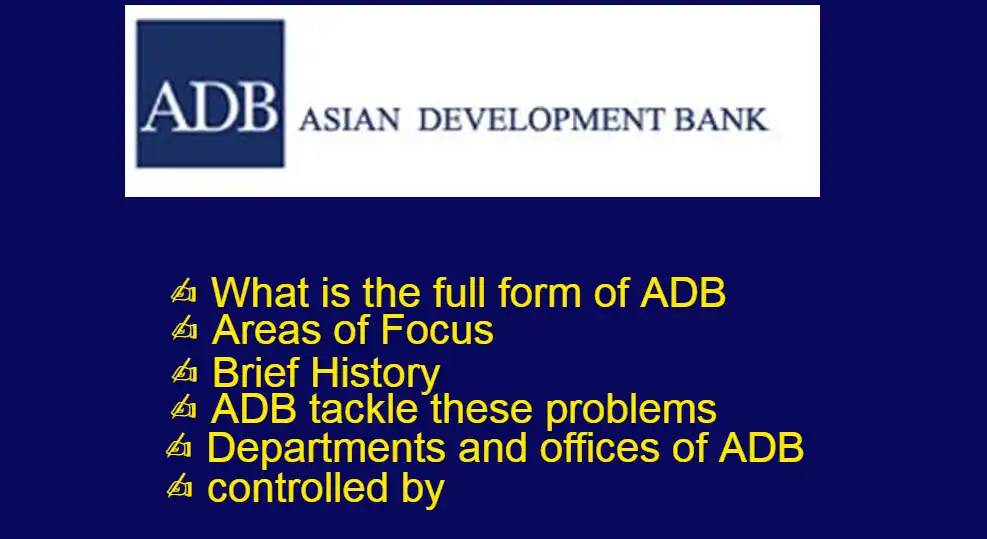ADB Full Form. Asian Development Bank (ADB) is a regional development bank established in 1966 to promote economic and social development in Asia. The bank has its headquarters in Manila, Philippines as of July 2017 and its main objective is to assist its member countries, in particular those in the Asia-Pacific region, by providing loans, technical assistance, grants, and equity investments to promote economic and social development.
ADBFull Form 1 Asian Development Bank and 2. Android Debug Bridge
1. What is the full form of ADB?
What's Next
ADB also focuses on reducing poverty and promoting sustainable economic growth, as well as regional cooperation and integration in Asia. It has 67 members and 48 of them are from the Asia-Pacific region. Masatsugu Asakawa is the president of the Asian Development Bank (ADB) and Shixin Chen is the Vice-President of ADB.
Areas of Focus
The Asian Development Bank (ADB) has several areas of focus in order to achieve its objectives of reducing poverty and promoting sustainable economic growth in the Asia-Pacific region. Some of these areas include:

Infrastructure development: ADB provides funding for the development of transportation, energy, water and sanitation, and other critical infrastructure projects in its member countries.
Financial sector development: ADB helps to strengthen financial systems and promote access to financial services in its member countries, including through the provision of technical assistance and capacity building.
Regional cooperation and integration: ADB supports efforts to enhance cooperation and integration among countries in the Asia-Pacific region, including through trade facilitation, transport connectivity, and energy integration.
Sustainable and inclusive growth: ADB aims to support member countries in achieving sustainable and inclusive economic growth that benefits all segments of society, including the poor and vulnerable.
Climate change and environment: ADB helps to reduce greenhouse gas emissions, increase resilience to climate change, and promote sustainable use of natural resources in its member countries.
Gender and development: ADB integrates gender considerations into all its operations and aims to promote gender equality and women’s empowerment.
All these areas of focus are implemented to achieve the goal of poverty reduction and inclusive economic growth, which is the main objective of ADB.
ADB supports projects in developing member countries that create economic and development impact, delivered through both public and private sector operations, advisory services, and knowledge support.
ADB provides its member countries in Asia and the Pacific with the knowledge and expertise to tackle these problems
- Agriculture and Food Security
- Climate Change and Disaster Risk Management
- Digital Technology
- Education
- Energy
- Environment
- Finance
- Fragility and Vulnerability
- Gender and Development
- Governance
- Health
- Public-Private Partnerships
- Regional Cooperation and Integration
- Social Development and Poverty
- Sustainable Development Goals
- Transport
- Urban Development
- Water
Brief History
The idea for the ADB was first proposed in the late 1960s by the Philippine government, which recognized the need for a regional development bank to support economic growth and development in the Asia-Pacific region. The proposal was supported by other countries in the region, including Japan.
ADB was established On 19 December 1966, with 31 member countries and Takeshi Watanabe as its first President.
ADB’s first bond issue worth $16.7 million was issued in Japan In 1970.
Asian Development Fund was established to provide low-interest loans to the poorest member countries In 1974.
In 1982, it opened its first field office in Bangladesh to come closer to the people in need.
In the 1990s, ADB began to place a greater emphasis on poverty reduction and sustainable development. During the same time, ADB started to increase its support for the private sector, recognizing its important role in driving economic growth and development.
In mid-1997, during a severe financial crisis in the region, it started projects
In 2004, it spent over $800 million on the recovery of tsunami-affected areas in Sri Lanka, India, Indonesia, and the Maldives.
In 2008, it launched a new long-term strategy framework ‘Strategy 2020’
In 2014, a midterm review of the “Strategy 2020” changes were introduced to improve the business processes.
In the new century, ADB continues to address development challenges in the Asia-Pacific region and adapt to changing circumstances. ADB’s strategy for 2020-2023 focuses on addressing the region’s increasing economic and social inequality and the urgent need for climate action.
ADB has been an active player in supporting its member countries through the COVID-19 pandemic as well and has rolled out multiple initiatives to help its member countries recover from the economic impact of the pandemic.
The full Form of ADB is the Asian Development Bank
Check other Full forms
- What is WHO- WHO Full Form, Know The Organization’s Work, Purpose, And History
- Hmm Full Form in Hindi | Know Hmm meaning in Hindi, Tamil, Marathi
- Full Form of MLA- Know about MLA- What is OPD?
- NDA Full Form- All You Need To Know About NDA- National Defence Academy
- CEO Full Form: What the CEO Full Form Means to You
- BTS Full Form: Know about Full form of BTS
- APK Full Form: Full Form of APK in Hindi
- UPSC Full Form: What is UPSC and its functions and related information
- Full Form of INDIA — What is the full form of INDIA? 20+ Name of India
- RIP full form: What is the full form of RIP?
Departments and offices of ADB
The Asian Development Bank (ADB) is organized into several departments and offices, each with a specific function and mandate. The main components of ADB’s organizational structure include:
- Board of Directors: The highest decision-making body of ADB, consisting of representatives from each of the 67 member countries.
- President: The chief executive officer of ADB, responsible for the overall direction and management of the bank.
- Independent Evaluation Department: Independent evaluation of ADB’s operations and activities
- Office of the General Counsel: Legal and compliance for ADB
- Office of the Secretary: Coordination of the bank’s administrative and financial operations
- Operations Department: Oversees all of ADB’s loan and grant operations
- Private Sector Operations Department: Facilitates private sector development in the region
- Strategy, Policy, and Review Department: Responsible for the development of ADB’s strategic direction and policies, as well as monitoring and evaluation of the bank’s performance
- Regional and Sustainable Development Department: Coordination of ADB’s regional cooperation and integration initiatives
- Office of the special units: Special units to support ADB’s operations in areas such as gender, environment, and climate change
This is a general outline of the main components of ADB’s organizational structure. It’s worth noting that the structure is subject to changes and it also has other departments and offices that support the main ones in achieving the main goals of ADB.
The Asian Development Bank is controlled by
The Asian Development Bank is controlled by its Board of Directors, composed of representatives from the member countries, who make decisions on the use of ADB’s resources and set the overall strategic direction of the bank, and the President who is responsible for the management of the bank and accountable to the Board of Directors. The top five shareholders of the ADB as of 2022 are the People’s Republic of China (6.4%), India (6.3%), Australia (5.8%), Japan (15.6% each), and the United States.
2. Understanding ADB: Android Debug Bridge
What is ADB?
Android Debug Bridge, commonly known as ADB, is a command-line tool that enables communication between a computer and an Android device. It acts as a bridge, facilitating the transfer of commands, data, and files between the two entities. ADB forms a vital part of the Android Software Development Kit (SDK) and serves as an indispensable tool for developers, testers, and power users.
The Full Form of ADB
ADB stands for Android Debug Bridge. The term “Debug Bridge” emphasizes the tool’s primary purpose, which is to facilitate debugging and troubleshooting processes during Android application development.
The Functionality of ADB
1. Application Installation and Removal
ADB allows seamless installation and removal of applications on Android devices from a computer. Developers can effortlessly deploy their applications for testing purposes, eliminating the need for manual installation on individual devices.
2. File Management
With ADB, developers can easily manage files on an Android device. It enables the transfer of files between the computer and the device, providing a streamlined approach for moving assets, configuration files, and other resources.
3. Debugging and Logcat
ADB offers a comprehensive debugging environment for Android applications. Developers can monitor logs, track system events, and analyze application behavior using the Logcat feature. This helps in identifying and resolving bugs, enhancing the overall stability and performance of the applications.
4. Device Control and Shell Access
ADB provides developers with fine-grained control over connected Android devices. It allows them to execute shell commands directly on the device, granting access to advanced functionalities and system settings. This level of control proves invaluable when debugging complex issues or customizing device behavior.
5. Port Forwarding
ADB enables port forwarding, which establishes a connection between a port on the computer and a port on the Android device. This feature facilitates testing and debugging network-related functionalities in Android applications, ensuring seamless integration with server components.
6. Screen Capture and Recording
Developers and technical writers can utilize ADB to capture screenshots and record the screen of an Android device. This functionality is particularly useful for creating tutorials, documentation, and promotional material, providing visual aids for users and readers.
ADB and its Significance in the Android Ecosystem
ADB plays a pivotal role in the Android ecosystem, contributing to the growth and innovation in the field of mobile app development. Its extensive range of features empowers developers to create high-quality applications, streamline the testing process, and enhance the overall user experience. Moreover, ADB acts as a catalyst for the continuous improvement and evolution of the Android platform.










